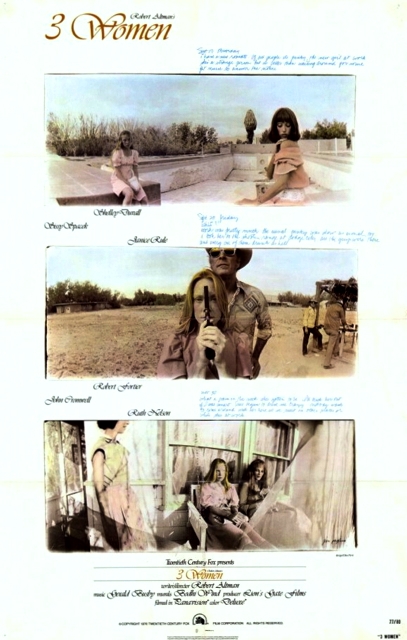
“I’m trying to reach toward a picture that’s totally emotional, not narrative or intellectual.” – director Robert Altman
Enigmatic, strange and ambiguous for people who want to see another variation of “Persona” (which came before) or “Mulholland Dr.” (which came after). Robert Altman’s Three Women (1977) is flatly, deadpan kind of weird and simply one of the weirdest of all films. It is either a struggle or a welcome challenge for a viewer to piece it all together. For me, it is not as great as either of the two aforementioned films, it’s self-consciously screechy (I’m talking about the audio effects, the clanking muzak), but it’s a fascinating puzzle for those who study the psychology of maladjusted people. That a film would even dare to be about maladjusted outcasts that don’t fit in is an accomplishment.
Shelley Duvall and Sissy Spacek star as workers at a nursing home in the California desert. Duvall is Millie Lammoreaux, a perpetual chatterbox who won’t stop long past others have long given up listening. Spacek is Pinky Rose (or Mildred), an outsider new to town, who is so childlike and juvenile that she doesn’t seem qualified to even work at this nursing home. Millie, always bugging people to the point they revolt, needs a new roommate and Pinky, desperate for a friend, jumps on the invitation.
Millie treats Pinky as her minion, and feeds her lies about how popular she is and adored by men. Edgar (Robert Fortier) is the only man around that listens to Millie and bothers to entertain her, but he does it in his own self-absorbed way – he’s a drunk, and he’s a selfish sonuvabitch we gradually learn. The third woman of the story is mysterious artist Willie (Janice Rule, often in a sun hat), pregnant, muted, and creates murals of godlike or reptilian creatures on the bottom of pools.
 Repeatedly, Millie is cheerful but clueless, inviting neighbors and locals to dinner parties she’s hosting but isn’t aware that she’s being stood up. Pigs in a blanket and chocolate pudding tarts are her idea of party spread sophistication, no one else’s. Millie has the gall to blame Pinky for her friends “not showing up,” and as a rebuke, welcomes drunk Edgar to sleep with her. (We have learned Edgar is the husband of Willie, the artist.) Pinky is devastated for being shunned as a pest, and what she does next, makes her end up at the hospital where she will lay unconscious.
Repeatedly, Millie is cheerful but clueless, inviting neighbors and locals to dinner parties she’s hosting but isn’t aware that she’s being stood up. Pigs in a blanket and chocolate pudding tarts are her idea of party spread sophistication, no one else’s. Millie has the gall to blame Pinky for her friends “not showing up,” and as a rebuke, welcomes drunk Edgar to sleep with her. (We have learned Edgar is the husband of Willie, the artist.) Pinky is devastated for being shunned as a pest, and what she does next, makes her end up at the hospital where she will lay unconscious.
Pinky’s parents arrive from out of town to see her at the hospital. “I’ve never seen them before,” Pinky harshly responds after she wakes up. Pinky, rebounding from the hospital stay, transforms into an entirely different person – sassy and bold, oozing self-confidence and trampiness. Edgar now switches his attention to Pinky over Millie, allowing Pinky to dominate her in the relationship.
Suddenly, we get an avante-garde sequence that supposedly is Pinky’s dream. The most critical thing I can say about this sequence is that it implies great trauma that took place long before the film’s starting events. Shown in the dream is Willie, the artist, foolishly in love with Edgar from long ago. But if it was Pinky’s dream, then how would she even have a subconscious inkling of Willie’s earlier life with Edgar if she didn’t know them? The answer, I think, is that Pinky has been a part of Willie and Edgar’s life all along.
After the strange dream, Edgar barges in, annoys Millie and Pinky, and says his wife Willie is giving birth. “Why aren’t you taking her to the hospital?” Millie asks. Willie gives birth from home, in a disturbing scene in the pitch black of night, and Altman fills the image with water, or secretion fluid during the birth scene. It feels pivotal to all their lives, a trauma that has engulfed them all.
Pinky, Millie and Willie all share something in common, their pathologies are crossed or not arguably, we don’t know. Do they all share the same traumas experienced within family? These are questions that Altman himself has not answered. And yet this is an invaluable film, it is disorienting and disturbing.
The one question I think you should ask: If the film has any one individual POV, which character do you think the film represents? If you have chosen one character of the three, what do you think it says about her damaged subconscious? In any circumstance, I don’t think any of these characters could survive in a major city, they are too damaged to fit in a common social circle.
Altman says the film came directly from a dream he had, and convinced the studio to bankroll his film without a finished script. The script was completed before shooting began, but dialogue was largely improvised and the dream interpretation was predominantly concentrated upon. Altman’s other hallucination-heavy avante garde piece “Images” (1972) is not nearly as intriguing as this one.
 I have my own interpretation, that could be right, could be wrong, or just different from anyone else’s. During the childbirth scene (which I think is a remembrance in the form of a dream), Millie and Pinky are sisters. Millie slaps her sister for not calling a doctor, but really has been slapping and scolding herself throughout the rest of her lifetime for not doing enough then. Could the baby born be Pinky, even though the dialogue said the baby died while being born? I think Millie was sexually abused growing up by dad (Edgar), was often socially unaccepted, mistreated her sister Pinky as a coping mechanism, and feared her mother whom she felt she betrayed.
I have my own interpretation, that could be right, could be wrong, or just different from anyone else’s. During the childbirth scene (which I think is a remembrance in the form of a dream), Millie and Pinky are sisters. Millie slaps her sister for not calling a doctor, but really has been slapping and scolding herself throughout the rest of her lifetime for not doing enough then. Could the baby born be Pinky, even though the dialogue said the baby died while being born? I think Millie was sexually abused growing up by dad (Edgar), was often socially unaccepted, mistreated her sister Pinky as a coping mechanism, and feared her mother whom she felt she betrayed.
Then the curious final scene. Millie and Pinky stay by mom after she is presumedly widowed. I don’t blame any of the three women for putting Edgar underneath a pile of tires for eternity, if that is what happened (or not). But then again, maybe the whole thing is a dream. Like Altman implied it was.
123 Minutes. Rated R.
PSYCHOLOGICAL DRAMA / MIND-BENDER / AFTERNOON WEIRDNESS
Film Cousins: “Last Year at Marienbad” (1961, France); “Persona” (1966, Sweden); “Images” (1972); “Mulholland Dr.” (2001).





